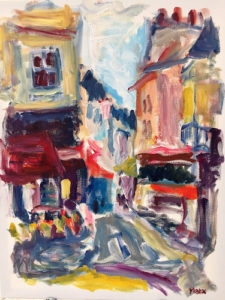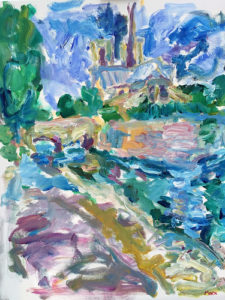Dear Artist,
After noting the tendency of kindergarten kids to keep pushing paint until their images were destroyed, Susan Marx of Orange, N.J., wrote, “You raise an important question. How do you know when to stop? If the best result of the painting is obtained during the first five minutes — when your excitement, emotions, instincts and experiences are all lined up — are you supposed to stop right then before your brain takes over? How does one prevent overworking?”
Thanks, Susan. For many of us, overworking is chronic and out of control. Looking at your work, it seems to me that you are one who has beaten it. Your paintings are fresh, direct and understated — you’re hardly a victim of overworking. Overworking has many causes. Here are a few: Perfectionism presses atavistically on the human soul. The need for something better, something perfect is hard-wired into our DNA. Unfortunately, some people think perfection can be achieved by simply continuing. Guilt is that part of human nature that has us think we need to give or do something penitent to be more worthwhile within ourselves. Unnatural sacrifice and latent guilt are the wrong reasons to do anything.
Facility is the persistence of a particular skill or technique. The mere presence of cleverness does not obligate its use. Example: A talented draftsman may become tedious with too much drawing. The fear of unknown outcome. This is a tricky one. While a lot of art involves exploration and discovery, another ploy is to have a pretty clear idea how you want to end up, and stop there. When an outcome is unknown, there’s a tendency to continue to work toward an unsatisfactory one. “To be a painter,” said Picasso, “you need to know how to paint, and when to stop.” Too much riding on it. Artists often notice overworking when expectations or obligations are highest, such as commissions or solo shows. Spontaneity fails. Tossed-off sketches or field work seem to fare better. A casual attitude begets freshness. Thinking too much. Susan got it right when she said, “before your brain takes over.” Sure, thinking is good, but your brain is perpetually thundering down the tracks with intent to derail your creativity. Clutter. In art, it’s often what you take out, not what you put in. As a general rule, artists need to smile on simplicity and frown on the extraneous.
Best regards,
Robert
PS: “Art is the elimination of the unnecessary.” (Pablo Picasso)
Esoterica: A healthy ego, whether genuine or affected, builds confidence in what you do. The extreme egotist thinks he’s doing just fine, no matter what. “If I spit,” said Pablo Picasso, “they will take my spit and frame it as great art.” Childlike and self-focused, even the mild egotist has little time or inclination for overworking.
This letter was originally published as “The causes of overworking” on November 26, 2010.
Have you considered a Premium Artist Listing? With each letter, an artist is featured at the bottom of this page. The Premium Artist Listings are a means of connecting artist subscribers through their work. Proceeds from each listing contribute to the production of The Painter’s Keys.
Featured Artist
Shawn’s paintings evoke the feelings of the West Coast, its shores and islands, ponds and lakes.







16 Comments
Overworking isn’t always about knowing when to stop. Sometimes it’s about knowing when to push forward. An overworked painting is in that middle ground. Too much and not enough.
Overworking can be a good thing! Years ago when I was in college studying for a degree in art education, we visited an elementary school and a class of 2nd graders that were immersed in an art project. They had been on a field trip to a fire station and upon returning, the teacher asked the students to draw a picture of their experience. I recall that one student was drawing a building that appeared to be burning, When I returned to his desk, he had superimposed a fire truck and ladders over the building. A few minutes later, he scribbled black crayon over the entire surface of his drawing. I asked him to explain his artwork. He said that the building was on fire, the firemen arrived, the building burned down, the firemen left and nothing but smoke remained!
He painted the last frame of a movie (motion picture). Beautiful!
Now that was spontaneous!
Less is always More. Let the viewer use their imagination also …
A great reminder.
Define “over working” ?
This is when a painting buddy can be helpful. I had someone with whom I regularly painted and my job was to tell her, “Stop! Look again tomorrow!” And sometimes when she was unsatisfied and looked to me, I was able to say, “Try a little dab of red there.”, or “a little dab of white there”.
Thanks for publishing an oldie but goodie… reading your newsletter is is like a sip of fine champagne it seems like your father always hits the right notes at the right time with a compositioa that will last forever . …you are like a great wine maker who knows when to uncork a vintage wine at the right time and you have the taste buds to appreciate its bouquet so.pkeasing to the palate developed from being around him and something of the uniqueness which all you Genn’s seem to have inherited to see, say and serve an old type of wine in a new type of wineskin ..the captured imagination of art and the beauty of the first impressions are too often twin victims murdered every day by the overworked. sorry about the terrible prose
Sometimes I want to stop, but also paint a replica to push forward, because I think the more-worked version would be good also–maybe better!
Didn’t Monet say that “ a painting is never finished.”?
I am always surprised at what a difference it can make to leave a painting over night and come back in the next morning and see it with fresh eyes. Maybe it’s just a few small tweaks but those tweaks may be what makes the painting work. I think, in my experience, that those tweeks are mainly to perk up the contrast in a few areas. If you are uncertain on what steps to take leave the painting where you can see it each day and try to look at it with a critical eye. It will come to you eventually. I agree with Pauliine that a painting buddy can also be a help but remember that you are free to accept as well as reject advice.
Thank you for this newsletter. I have been a fan for many years.
I agree with your message, Maxine Price. This is the approach that I take on every painting I create: I leave the painting where I can see it objectively for several days, and each time take the time on these occasions to look with a critical eye and make tweaks that will enhance the work. It seems to work for me.
I think that over working is part of the education in knowing when to stop.
Keep It Simple
As a relative beginner using colour I am very conscious that I need to push pictures into ‘overworked’ and beyond! The minimalist sketch approach is very attractive because the uncertain lines buzz with life, the hand of the artist is clearly present and the viewer completes the picture mentally (and therefore ‘perfectly’). This is fine when actually sketching – and may be all that can be done from life with a scene in flux – and may also help the craft by training the eye/brain – so it is certainly the way to work in a sketchbook. However, say, an oil painting completed in the studio is another matter: I think it is worth as far as possible fully resolving the ideas (though that is hard to define, and I really don’t mean fill in all the detail or paint photorealistically!). If I stop short with an oil painting for fear that any more may ruin it, I ask myself whether I have fully resolved the work (and not ‘is it now at its most attractive?’). If not, carry on, take the risk, have a crisis – from which the work can either maybe be a step change better – or end up in the bin or scraped off. The old movie of Picasso at work in its final colour section has him painting what to me looks a perfect bit, only to have him remove it and replace it with a (better) cubist version – and elsewhere he removed the good to make the better (we’re not all Picassos I know!). I think Matisse said valuable things in ‘Notes d’un Peintre’: something about how getting beyond the attractive phase you move into a deeper and more expressive phase. I think Delacroix wanted work fully resolved, and I thought Picasso didn’t like the ambiguity of abstract art – preferring resolved work. So for me – that lovely attractive sketchiness is a trap – and the attractiveness can cause a halt that prevents the really expressive work from taking shape. Also of course for a beginner my natural laziness asks me to stop – any more will be troublesome to resolve – and wow! how lovely it looks now!!